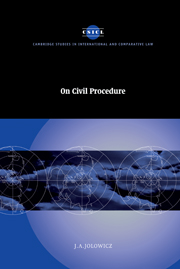Book contents
- Frontmatter
- Contents
- Preface
- List of abbreviations
- Introduction
- I The litigation process
- II Protection of diffuse, fragmented and collective interests
- 5 Introduction
- 6 Aspects of U.S. and French law
- 7 English law
- III Procedural modes
- IV The parties and the judge
- V Recourse against judgments
- VI Procedural reform
- Index
- CAMBRIDGE STUIDES IN INTERNATIONAL AND COMPARATIVE LAW
6 - Aspects of U.S. and French law
from II - Protection of diffuse, fragmented and collective interests
Published online by Cambridge University Press: 18 December 2009
- Frontmatter
- Contents
- Preface
- List of abbreviations
- Introduction
- I The litigation process
- II Protection of diffuse, fragmented and collective interests
- 5 Introduction
- 6 Aspects of U.S. and French law
- 7 English law
- III Procedural modes
- IV The parties and the judge
- V Recourse against judgments
- VI Procedural reform
- Index
- CAMBRIDGE STUIDES IN INTERNATIONAL AND COMPARATIVE LAW
Summary
The United States
‘Public interest actions’
Though the Attorney-General may bring proceedings himself, the ‘relator action’ as known in England and a number of other common law countries has not developed in the United States. For the ordinary plaintiff the basic rule used to be that only a person who could allege the infringement of a legal right of his own had the necessary ‘standing’ to bring civil proceedings. This meant, for all practical purposes, that he must allege damage to himself and that, on the face of things, left little room for ‘unselfish’ litigation. In 1940, however, a licensed radio station challenged the legality of the grant of a licence to a rival station. The plaintiff's motivation is unlikely to have been unselfish and the legislation was not intended to protect radio stations from competition. Nevertheless, the action was entertained because, in the Supreme Court's opinion, judicial scrutiny of the action of the licensing authority was in the public interest, and yet only persons likely to be injured financially would have an incentive to bring errors on the part of the authority to the attention of the courts.
The idea of harnessing a person's desire to obtain a personal benefit which would, at best, be no more than an unintended byproduct of the law, in order to have matters of public interest brought before the courts, led to the theory that ‘injury in fact’ - which does not require the infringement of a legal right - will suffice where there is thought to be need for the intervention, in the public interest, of a ‘private attorney-general’.
- Type
- Chapter
- Information
- On Civil Procedure , pp. 109 - 121Publisher: Cambridge University PressPrint publication year: 2000



